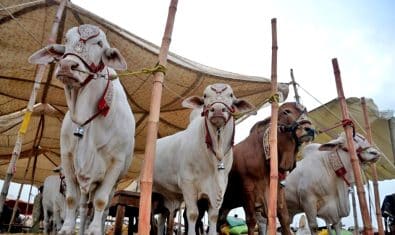Pakistan’s political crisis since April 2022 has laid bare some logic-shattering narratives over what (read: who) is to blame for the country’s economic ruin so far.
‘Corrupt’ and ‘broke’ are words no country – and no people – want to be associated with their economy. And yet it feels like a disservice when looking at the economic crisis in Pakistan.
A lack of macroeconomic transparency on the part of caretaker Prime Minister Anwaarul Haq Kakar and the public image-building stunts of IT Minister Dr. Umar Saif have made it difficult to accurately gauge the extent of the country’s problems.
The International Monetary Fund (IMF) has revised GDP growth rate projection downward for Pakistan by 0.5 percent to 2 percent for 2024.
According to the International Monetary Fund, Pakistan’s GDP is expected to grow by 2% in 2024, compared to 2.5% in its previous update. Last year, it is estimated to have shrunk 6%, and exacerbating the pain is hyperinflation, which analysts more blunt than the crises lender suggest could open old wounds like ‘a PKR below 310/$’ and ‘petrol back above 300/liter’.
“Disruptions at the highest level of governance have always made economic growth a pipedream since the 1950s. From a non-existent debt-free nation to a burden rising above $130 billion today, our history isn’t short of examples that clearly show how illogical interventions kill progress. Citizens deserve better, and so does the economy,” said an analyst.
Beneath such unfathomable and gut-wrenching circumstances is a procession of profound misery and a color pattern contaminated by green. Around five million people have left Pakistan in search of jobs abroad in the past decade. The public health system is in ruins. Electricity is unbearably expensive. Food costs rising every week. Malnutrition is looming.
Issues
Pakistan’s rapid economic decline can be attributed to many factors that were evident even before the infamous events of 2022 which saw one politician ousted at the expense of installing another and seemingly-opposite state servant. Following events saw the Pakistani Rupee shed roughly Rs. 140 against the US Dollar which was and still is, Pakistan’s primary economic driver, with forex reserves witnessing a startlingly rapid and disastrous decline from $22 billion to around $2.6 billion after the regime change. Indeed, the 2022 PKR collapse, at a time when the international Brent benchmark had started rising above $100 per barrel, triggered a crisis that shook South Asia’s most high-profile under-developed economy to its core.
Against public opinion, Western countries led by the United States have showered support behind the current state of democracy in Pakistan. Meanwhile, Russia, China, Iran and Turkey are waiting for a change of leadership while being aware of reports of widespread election fraud.
One thing that is not in dispute is the pivotal role Finance Minister Dr. Shamshad Akhtar has played. Shying away from taking credit where it’s due, the caretaker managed to get more cash out of IMF and helped set the Finance Division on a correction course by collecting record tax revenue via FBR and enforcing a net-zero current account policy to help balance out the scourge of trade deficit.
Rising inflation has prevented welfare programs aimed at redressing inequality and poverty. But when global oil prices started to plummet earlier in 2023, the new government led by Shehbaz Sharif was ill-prepared to offer respite to the general public and instead hiked petroleum rates to above Rs. 300 per liter.
“They didn’t’ save up for a rainy day,” a banker said. “They didn’t make the long term investments and offering no reparations crude has angered the general public.”
Pakistan nearly defaulted on various debt instruments last year when Ishaq Dar was appointed commander-in-chief Finance Division. Restructuring and mostly rollovers from China, KSA and UAE helped but Moody’s Investor Service noted in its November report that Pakistan is the most vulnerable to the balance of payment (BOP) crises among the South Asian sovereigns due to low exports and FDI, combined with much weaker policy management and higher political risk.
Pakistan historically has made little effort to tap that vast hydrocarbon wealth with its vast reserves in Balochistan, a far more lucrative source of wealth that unfortunately exists for the benefit of foreign enterprises like Barrick Gold. Over 80% of Balochistan’s natural reserves are associated with gas, copper, gold, and other hydrocarbons, with it estimated that Pakistan wastes all of it to foreigners.
Currently, Saudis have expressed interest in entering Pakistan’s mining industry. While this offers an enticing means of bolstering economic growth through the exploitation of Pakistan’s natural reserves game and using it to ease its dollar shortage, it could still run afoul if a new government isn’t allowed to function properly.
Views expressed here do not necessarily reflect ProPakistani or its owners.






















Is thus srticle for pti or for Pakistan as u started like that but u forgot that the buggest loan was taken by that government n than things got out of everyone’s control but what shame is that u blame ousted of that corrupt guy a biggest backdraft of economy